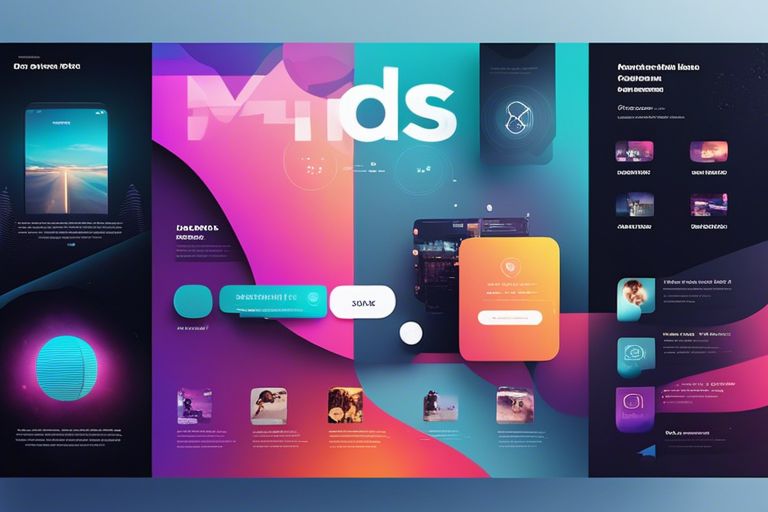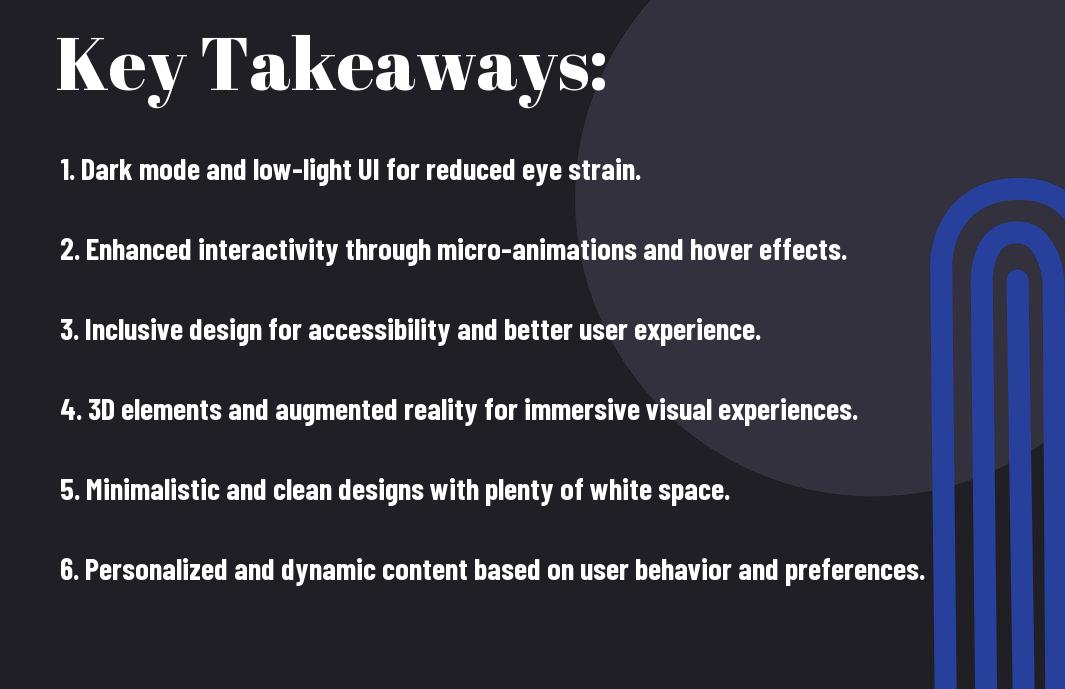Delving into website design trends is crucial for keeping your online presence up-to-date and competitive. As technology continues to evolve, so do your website’s design needs. In the coming year and beyond, it’s essential to stay ahead of the curve by embracing the latest trends that can elevate your website and captivate your audience. From immersive digital experiences to minimalist interfaces, understanding the biggest website design trends for 2022 and beyond will help you create a compelling and engaging online presence that makes an impact.
Key Takeaways:
- Responsive design: Websites must be optimized for various devices to cater to the increasing mobile user base.
- Minimalist and clean layouts: Streamlined and clutter-free designs will continue to dominate to enhance user experience.
- Dark mode: Offering a dark mode option will cater to user preferences and reduce eye strain, especially in low-light environments.
- Interactive storytelling: Engaging users through immersive and interactive narratives will be a growing trend in website design.
- Accessibility: Designing with inclusive features, such as user-friendly navigation and readable fonts, will be a priority for websites to cater to diverse needs.


The Rise of Mobile-First Design
One of the biggest website design trends for 2022 and beyond is the rise of mobile-first design. As more and more people use their smartphones and tablets to browse the internet, it’s becoming increasingly important to prioritize the mobile experience when creating a website. According to Top 10 Design Trends For 2022, mobile-first design focuses on creating websites that load quickly and provide an optimal experience for mobile users.
Responsive Design as a Standard
Responsive design has transitioned from being a trend to a standard practice in web design. With the rise in mobile browsing, it’s essential that your website is compatible with various screen sizes and devices. This means your website will automatically adjust and adapt to the user’s device, whether they’re visiting from a desktop, smartphone, or tablet. This not only provides a consistent experience for your visitors but also ensures that your website remains accessible to a wider audience.
The Impact of Mobile Usage on User Experience
The increasing use of mobile devices has a significant impact on user experience. When someone visits your website on their mobile device, it’s crucial that they can easily navigate, access information, and perform actions. If your website isn’t optimized for mobile, you risk losing potential customers and damaging your brand reputation. By prioritizing mobile-first design and ensuring a seamless experience for mobile users, you can improve engagement, increase conversions, and strengthen your online presence.
Minimalism and Simplicity
For the latest website design trends, minimalism and simplicity are continuing to reign supreme. As we move into 2022 and beyond, these timeless design principles are expected to remain at the forefront of web design. According to a recent article on crowdspring.com, the 11 Biggest Web Design Trends for 2022 also highlight the importance of minimalism and simplicity in web design for the coming year.
The Decluttering of Web Spaces
In the world of web design, cluttered and chaotic interfaces are a thing of the past. Users want an experience that is clean, organized, and easy to navigate. By decluttering your web spaces, you can create a streamlined and efficient user experience. By eliminating unnecessary elements and focusing on what truly matters, you can guide your visitors’ attention to the most important parts of your website. With clear and concise content, you can create a website that is a joy to use and explore.
Utilization of Negative Space
Incorporating negative space, also known as white space, into your website design is essential to create a sense of balance and harmony. Negative space helps to emphasize the key elements of your website, making it easier for users to navigate and digest the content. By strategically using negative space, you can create a visually appealing and engaging website that captivates your audience’s attention. Embracing negative space in your design will ensure that your website looks modern and sophisticated while also delivering a pleasant user experience.
Advanced Interactivity and Animations
Despite the rapid evolution of website design trends, one thing remains constant – the importance of advanced interactivity and animations in captivating and engaging your audience. Here are some of the key trends in this area:
- Scroll-triggered animations: These animations are designed to activate as users scroll through your website, creating a more dynamic and interactive user experience.
- 3D visuals and effects: The use of 3D graphics and effects adds depth and realism to your website, making it more visually appealing and immersive for your audience.
Microinteractions and Their Significance
In today’s digital landscape, the user experience is more important than ever. Microinteractions are subtle, yet significant design elements that can greatly enhance user engagement. These small, interactive details, such as animated buttons or feedback messages, can make a big impact on how users perceive and interact with your website. By paying attention to these small details, you can create a more intuitive and enjoyable experience for your audience.
The Role of Motion Graphics in User Engagement
When it comes to capturing and maintaining a user’s attention, motion graphics play a crucial role in enhancing user engagement. The use of animations, videos, and other dynamic visual elements not only make your website more visually appealing but also help convey information in a more engaging and memorable way. By incorporating motion graphics into your website design, you can make your content more compelling and impactful, ultimately keeping your audience more engaged with your brand and message.
Accessibility and Inclusivity
Now, when it comes to website design trends for 2022 and beyond, accessibility and inclusivity are becoming increasingly important. As the digital landscape continues to evolve, it’s crucial to ensure that your website is accessible to all users, regardless of their abilities or disabilities. In fact, according to a recent article on 20+ Trailblazing Web Design Trends 2023, creating inclusive and accessible web designs is one of the top priorities for web designers in the coming years.
Design for All: Prioritizing Universal Access
When designing your website, it’s essential to prioritize universal access to ensure that everyone, regardless of their abilities, can use and navigate your site effectively. This means considering factors such as color contrast for those with visual impairments, keyboard navigation for those who cannot use a mouse, and providing alternative text for images for those using screen readers. By prioritizing universal access, you can ensure that every visitor to your site has a positive user experience.
Compliance with Web Content Accessibility Guidelines (WCAG)
In addition to prioritizing universal access, it’s also important to comply with the Web Content Accessibility Guidelines (WCAG). These guidelines provide a set of recommendations for making web content more accessible, covering areas such as perceivability, operability, and understandability. By ensuring compliance with these guidelines, you can make your website more accessible to a wider audience and demonstrate your commitment to inclusivity and accessibility.
In summary, accessibility and inclusivity are key considerations for website design in 2022 and beyond. By prioritizing universal access and complying with WCAG guidelines, you can ensure that your website is accessible to all users, making it a positive and inclusive experience for everyone.
Artificial Intelligence and Personalization
Unlike traditional website design, the integration of artificial intelligence (AI) into web development has revolutionized the way websites interact with their users. AI has opened up a new realm of possibilities for personalized experiences, allowing websites to adapt and cater to the unique preferences and behaviors of each individual visitor.
AI’s Impact on User Experience
With AI, website designs can now analyze user behavior in real-time, making it possible to dynamically adjust the layout, content, and navigation to optimize the user experience. This means that your website can adapt to each user’s unique preferences, ensuring that they find the information they need quickly and easily. AI can also anticipate user needs, providing personalized recommendations and content based on their past interactions with the site. This level of personalized user experience can significantly improve engagement and satisfaction, leading to increased conversion rates and customer loyalty.
Customized Content Delivery
AI enables websites to deliver customized content based on individual user preferences, behavior, and demographics. By leveraging machine learning algorithms, your website can tailor the content displayed to each visitor in real-time, ensuring that they are presented with the most relevant and engaging information. This level of customization can enhance the overall user experience by providing personalized product recommendations, content suggestions, and targeted promotions that are more likely to resonate with your audience, ultimately leading to improved conversion rates and customer satisfaction.
Conclusion
Presently, it is crucial for you to stay ahead of the curve when it comes to website design trends. Embracing the latest techniques and innovations will not only enhance the visual appeal and functionality of your website but also keep your brand competitive in the digital landscape. As we move into 2022 and beyond, it’s apparent that the biggest website design trends revolve around user experience, interactivity, and personalization. By incorporating elements such as AI-powered chatbots, 3D elements, immersive storytelling, and dark mode options, you can create a website that captivates and engages your audience on a whole new level. So, be on the lookout for these emerging trends and consider leveraging them to your advantage for an improved online presence.
Website Design Trends for 2022 and Beyond FAQ
Q: What are the biggest website design trends for 2022 and beyond?
A: The biggest website design trends for 2022 and beyond include dark mode design, minimalist and simplified layouts, immersive storytelling through interactive elements, increased personalization and customization, and the use of 3D and augmented reality elements.
Q: How important is dark mode design in website design trends for 2022 and beyond?
A: Dark mode design is becoming increasingly important as it reduces eye strain and energy consumption for users, providing a sleek and modern aesthetic. It is a key feature that is expected to be prevalent in website design trends for 2022 and beyond.
Q: What role does immersive storytelling play in website design trends for 2022 and beyond?
A: Immersive storytelling through interactive elements such as parallax scrolling, video backgrounds, and animations is crucial for engaging users and creating memorable experiences. This trend is set to dominate website design in 2022 and beyond.
Q: How will personalization and customization impact website design trends for 2022 and beyond?
A: Personalization and customization allow websites to cater to individual user preferences, providing tailored content and experiences. This trend will continue to grow in importance as users seek more personalized interactions with websites.
Q: In what ways are 3D and augmented reality elements shaping website design trends for 2022 and beyond?
A: The use of 3D and augmented reality elements creates engaging and interactive experiences for users, bringing a sense of realism and interactivity to websites. This trend is expected to play a significant role in website design for 2022 and beyond, enhancing user engagement and overall design aesthetics.
